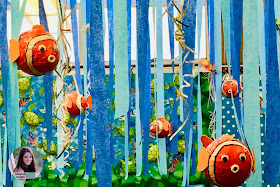When I taught first grade we used to transform our classroom into an ocean wonderland. This is one of the main things I miss about teaching first grade. Now that I am in second grade I think I may focus my attention to creating a rainforest wonderland, or perhaps a second grade version of the ocean wonderland my firsties and I loved so much!
I have had some questions about my paper mache clownfish that have been posted on the blog and Instagram. I thought I'd take this opportunity to post a "how-to" guide to help those of you wanting to create these adorable sea creatures with your class.
Here are the supplies you will need:
- Balloons (and pump if you want to make it easier on yourself!)
- Newsprint Paper
- Elmers Art Paste
- Small Containers for the paste
- Pitcher or Bucket
- Paint- Orange, White, and Black- My favorite brand is Jazz Gloss
- Model Magic
- Plastic Bowls
- Google Eyes
- Orange Foam
- Fishing Line
- Glue gun and hot glue
I like to do this project in small groups of 4 or five students, but it also works as a class. The easiest way to protect tables is to get plastic tablecloths to line the tables with. Towels are also great for spills and sticky hands.
Step Two: Pour a little paste into the containers and provide each student with a handful of newsprint. They will need more later, but give them a pile to start. I like to write their names on a bowl and put the balloon inside so it doesn't roll around all over the table. Have the students dip a paper into the paste and use two fingers to wipe off the excess into the bowl. They will then spread the paper onto the balloon. They will cover the balloon with one layer to start. Once the first layer is complete have the students cover the balloon with two more layers. You may take a break between layers and even complete layers on separate days (if you are willing to deal with the mess on multiple days!). Tip: sometimes the students' balloons get extra wet. Have the students just place dry newsprint on the overly wet parts without dipping back into the paste if necessary.
Step Four: Pour paint into containers and have students paint the balloon orange. One balloon dries, I have them paint white stripes on the balloon. Sometimes it looks great to line the white with black marker or black paint.
Step Six: Call students over one at a time and have them show you where they want you to attach fins, eyes, and mouth. This needs to be hot glued, so adult help is necessary. Glue on the pieces according to student directions. At this point I also write student names on the bottom of the fish with permanent marker.
Step Seven: Poke hole in top fin with end of fishing line, knot the top and add a glue dot with glue gun to hold. Fish can be hung from the ceiling to create your ocean wonderland!
Please comment with any questions you may have about these adorable clownfish!
Here are some other resources for your Ocean Wonderland Transformation!





















